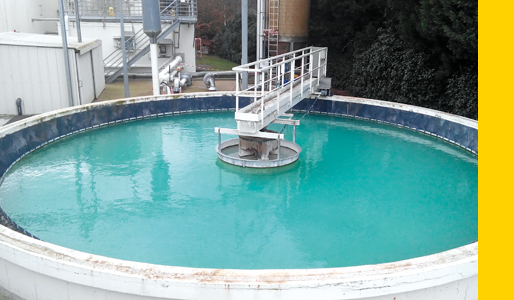Water
Water
Our Ambition
Maintain our leadership in water efficiency by reducing consumption, recycling more, and reinforcing our efforts in water scarcity areas.
2025 GOAL
-20%
water consumption*
* Normalized values vs 2016
Water is a limited natural resource that is essential to people, ecosystems and life. Manufacturing semiconductors requires a large volume of water. It also generates wastewater that can be harmful for the environment and local communities if not treated. Tackling the challenges of water scarcity and wastewater treatment has been part of our strategy since 1993. We have adopted a comprehensive approach to this, including water stress assessment, conservation programs, and wastewater treatment.
A limited and shared resource
The reliability of the water supply for the semiconductor manufacturing process is essential, but water is a shared resource, and it is our responsibility to ensure our water use does not impact local ecosystems. All ST sites manage their water-related risks, according to their needs and water availability. Each site monitors the volume of water it uses and complies with local permits. One of our 11 manufacturing sites uses groundwater for their operations. In 2020, 14% of the water used throughout our operations came from groundwater and 86% from municipal water supplies.
Water withdrawal by source I 303-3 I SDG 6.4
As most of our primary water supply is local municipal water, it is fundamental to ensure the continuity of water supplies in the areas where we operate. We therefore engage in regular discussions with local stakeholders and implement solutions to reduce water extraction and consumption. In 2021, we will conduct a water assessment with an external partner, as we did in 2014, to assess our global water footprint and identify water stress areas, water-related risks of our operations, and our impact on local communities. I 303-1 I
Reducing our water use
2020 performance
41%
of water recycled and reused
In 2020, thanks to the continuous efforts of all our sites and teams, our water recycling rate remained stable compared to 2019, although our water consumption increased by 7% in absolute terms. This is mainly due to the integration of a new manufacturing facility and an extension to an existing one. Our Catania (Italy) and Ang Mo Kio (Singapore) sites, where water consumption is highest, identified specific actions to improve their water efficiency. Some of these actions have already started to be implemented; others will be deployed from 2021 onwards (see Focus).
We achieved an A- score in the 2020 CDP questionnaire on water security, confirming that our policies, management systems and programs are aligned with managing water sustainably.
Focus
Cooperating with external experts to reduce water footprint
ST is committed to reducing its water footprint to minimize the impact on water availability. Our Catania site (Italy) is one of our largest users of water. To address this issue, the site commissioned a specialist water management consultancy to advise on the best technological solutions to reduce water consumption and achieve our 2025 corporate goal of reducing water consumption by 20% vs 2016. Various solutions were suggested, such as recycling and reusing water from facilities and manufacturing areas. Based on this in-depth analysis, the site will define a detailed action plan and prioritize actions to develop concrete projects in the coming years.

Carles Crespo
Global Business Development Leader, Isle
ST initiated a partnership with the Isle Group to reduce water consumption at its Catania site (Italy). After a comprehensive update of the site’s water balance, we have identified different scenarios using innovative water technologies that could achieve water savings up to an astonishing 35%, with a payback period of less than three years. An essential part of the study’s success was the immense commitment and technical support from local staff.”
Conservation initiatives
Our facilities and environmental teams are fully engaged in implementing new projects to reduce the water footprint of our operations and minimize the impact on water availability.
72%
reduction in our water footprint since 1994
Through our continuous efforts, we have succeeded in reducing our overall water footprint by 72% (per unit of production) since 1994.
In Morocco, where water is a scarce resource, our Bouskoura site has, for a number of years, initiated various action plans to reduce its water consumption. In 2020, a redesign of the site’s wastewater treatment plant made it easier to classify distinct types of wastewater and treat them accordingly. This enabled the site to increase the wastewater recycling rate from 35% to 60%. By improving the scale and efficiency of its water recycling, the site reduced not only the amount of water it needed to draw from local supplies, but also the impact on the local ecosystem.
Our Calamba site (the Philippines) initiated a project in 2020 to recover and treat water from manufacturing processes for use in the cooling towers. In one year, the project almost doubled the amount of recycled water used for the power plant and cooling towers.
At our Shenzhen site (China), as part of our efforts to increase water recycling, teams improved the system for recycling wastewater from the ultrafiltration system, including better monitoring.
Typical ST water cycle
Efficient wastewater treatment to reduce impact
Wastewater from our manufacturing processes contains pollutants that need to be treated to eliminate any risk of pollution. Wastewater is treated on site or externally in dedicated treatment plants. I 303-2 I
Our manufacturing sites are continually looking for ways to improve wastewater treatment and water discharge quality to minimize our impact on the environment.
For example, by changing the process parameters of the wastewater treatment plant, our Tours site (France) reduced the amount of lime required to treat the wastewater by more than 200 tons and the amount of CO2 by more than 40 tons. This decreased the transportation impact by the equivalent of 30 tons of CO2 and reduced the waste generated (sludge) by 30%.
Our Ang Mo Kio site (Singapore) upgraded its fluoride wastewater treatment plant to improve its performance and simplify maintenance, while addressing potential environmental and safety concerns related to the handling of chemicals and hazardous waste. Processes were changed so that instead of generating large volumes of waste sludge that require further treatment before sending to landfill, it produces dense pellets that can be recycled (see Waste). This project not only reduces operational and disposal costs, but also helps to minimize our impact on the environment and reduce the risks for people. The site has already seen an improvement and is on track to achieve a 100% recycling rate for fluoride wastewater in 2021, compared to 30% before the upgrade.
Contributing to the Sustainable Development Goals
Our commitments and programs related to Water as described above contribute to:
SDG target 6.4 – Substantially increase water-use efficiency across all sectors and ensure sustainable withdrawals and supply of freshwater to address water scarcity.
SDG target 8.4 – Improve progressively, through 2030, global resource efficiency in consumption and production.
2020 OBJECTIVES |
Status |
Comments |
|
Water recycle rate ≥45%. |
|
41% |


